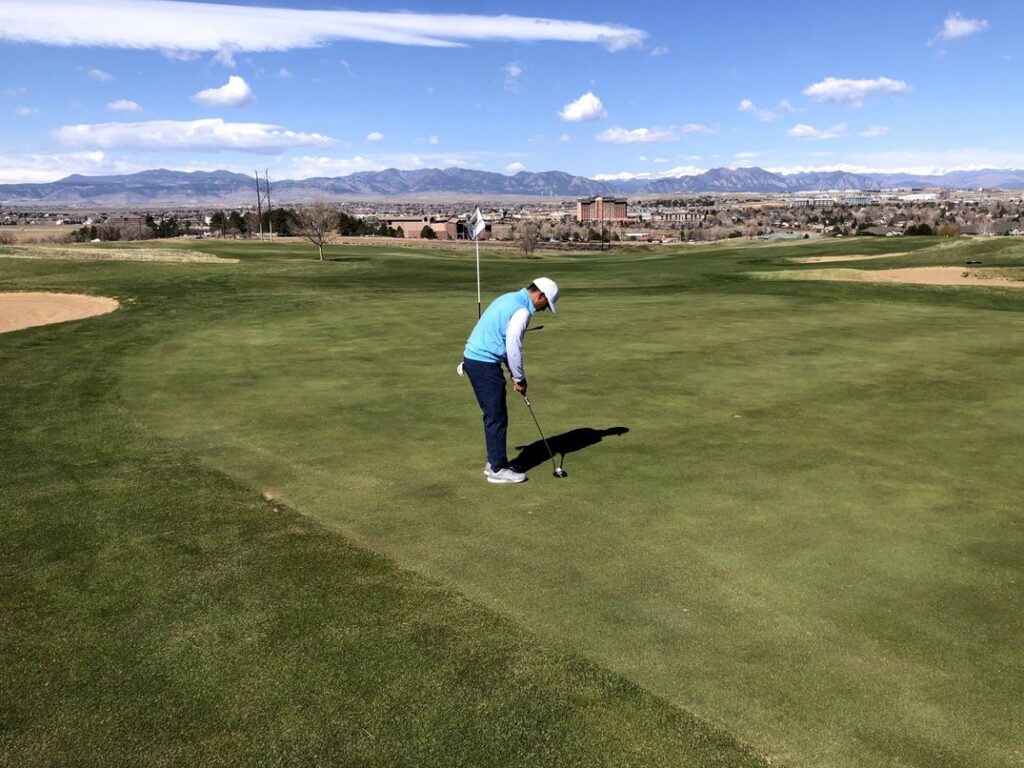In the world of golf, putting is often considered the great equalizer. A great putter can overcome a weak day of driving or iron play. But sometimes the putt you need isn’t one that goes in on the first try. Depending on your situation on the green, a safe putt is sometimes the smart play and a sign of a strong course management strategy. That’s where a lag putt can help.
Lag putting is a technique to control distance on long putts and is an essential skill when you’re trying to avoid a disastrous score on a particular hole.
What is a Lag Putt?
A lag putt is a long putt made with the primary goal of getting the ball close to the hole without necessarily aiming to sink it in one stroke. Essentially, a lag putt is a long putt that you don’t expect to make, but hope to get close to the hole.
The term “lag” in lag putting refers to the idea of controlling the distance and speed of the putt to leave the ball in a favorable position for an easier second putt.
Objective of a Lag Putt
The primary objective of a lag putt is to avoid three-putting, which is when a golfer takes three strokes to complete the putting on a hole. By accurately judging the distance and controlling the speed, golfers aim to leave the ball within a short and manageable distance from the hole on their first putt. This significantly reduces the risk of three-putting and helps to save strokes on the golf course.
Benefits of Lag Putting
Lag putting, often described as “the putting art of distance control,” refers to the skill of accurately judging and controlling the distance of your putts, particularly on long ones. It might not be as glamorous as sinking a dramatic 30-foot putt, but it is just as vital for a golfer’s success. Here’s why lag putting is crucial:
- Stroke Saver: Mastering lag putting can significantly lower your score. By consistently leaving your ball close to the hole, you reduce the likelihood of three-putting, which is a common cause of high scores.
- Match Play: If you’re in a match play and you are 2 strokes up on the last hole, you want to be sure you don’t lose that last hole by 2 strokes. Lag putting is a safe putt to ensure that you don’t get too aggressive and hit your putt too far past the hole.
- Course Management: Proper lag putting is an integral part of course management. It allows you to strategically place your ball on the green for easier short putts, thus improving your chances of sinking them.
- Confidence Booster: The ability to consistently control the distance on your putts gives you a boost of confidence. You’ll approach long putts with less fear and more focus, knowing you can get close to the hole.
When to Use Lag Putting
Lag putting is particularly important on long putts, typically those over 30 feet, where the primary goal is to set up an easy second putt for a one-putt finish. It’s a skill that requires a golfer to assess the speed and slope of the green accurately and execute a putt that stops near the hole, even if it doesn’t go in.
Lag putting is not a one-size-fits-all approach. Here are some times when you should consider a lag putt:
- Long Distances: Lag putting is most effective when you have a long putt, typically over 30 feet. At these distances, the primary goal is to leave the ball close to the hole for an easy second putt.
- Sloping Greens: On greens with substantial slopes, lag putting is crucial. By controlling the distance, you can avoid leaving yourself with downhill putts, which can be extremely challenging.
- Fast Greens: When you’re playing on fast greens, lag putting becomes even more critical. The speed of the greens can make it easy to send a putt racing past the hole if you’re not careful.
- Match Play Strategy: In match play, lag putting can be a strategic weapon. By consistently placing your ball close to the hole, you put pressure on your opponent to make their putts to keep pace.
Common Grips When Lag Putting
When it comes to lag putting, golfers can choose from a few common putting grips, which help them maintain control and consistency on long putts:
Conventional or Overlapping Grip
This is the most widely used putting grip, where the fingers of the non-dominant hand (left hand for right-handed golfers and vice versa) overlap the fingers of the dominant hand. It provides stability and control.
Cross-Hand or Left-Hand Low Grip
In this grip, the dominant hand (right hand for right-handed golfers) is placed lower on the grip than the non-dominant hand. It can help with keeping the shoulders square to the target and preventing wrist manipulation.
The Claw Grip
This unique grip involves gripping the club with the palm of the non-dominant hand facing upwards and the dominant hand in a conventional position. It can help reduce tension in the wrists and promote a pendulum-like putting stroke.
Split-Hand or Pencil Grip
The split-hand grip requires the golfer to hold the putter grip with both hands separated, as if holding a pencil. It can enhance control and feel in the putting stroke.
Armlock or Belly Putter Grip
This grip is used with a longer putter that rests against the golfer’s forearm, creating stability and control. It can be particularly helpful on lag putts where distance control is crucial.
Ultimately, the choice of putting grip comes down to personal preference and what feels most comfortable and effective for each golfer. It’s essential to experiment with different grips and find the one that helps you maintain control and consistency when lag putting.
Lag Putting Drills
To excel in lag putting, you need to practice specific putting drills that improve your distance control and confidence. Here are some effective drills to consider:
- Ladder Drill: Set up a series of tees at increasing distances from the hole, e.g., 10, 20, 30, 40 feet. Putt from each tee, and aim to get as close to the hole as possible without going past it. This helps you develop a feel for varying distances.
- Clock Drill: Imagine the hole as the center of a clock, and place tees at 12, 3, 6, and 9 o’clock positions around it. Putt from each tee, attempting to finish within a foot of the hole. This drill improves your ability to control distance and direction.
- 3-6-9 Drill: Place three tees at 3, 6, and 9 feet from the hole. Start with the 3-foot putt and make it, then move to the 6-foot putt, and so on. The goal is to make all putts consecutively. This drill focuses on short putts but enhances your feel for distance.
- Random Distance Practice: On the practice green, pick various spots around the hole and practice putts from random distances. This simulates real-game situations where you encounter a variety of distances and slopes.
- Visualize the Hole: Before taking a lag putt, visualize the ball rolling into the hole. This mental practice can help you develop a better sense of the speed required for the putt.
Frequently Asked Questions (FAQs)
Let’s address some common questions golfers have about lag putting:
How can I improve my feel for distance on lag putts?
Practice is key. Regularly engaging in lag putting drills will help you develop a better sense of distance control. Over time, you’ll become more intuitive in your judgment.
What putter is best for lag putting?
While it ultimately comes down to personal preference, putters with a heavier head often provide better distance control on lag putts. Experiment with different putters to find one that suits your game.
Should I use a different putting stroke for lag putts?
Your putting stroke can remain consistent for lag putts, but you might adjust the length and speed of your backswing and follow-through. A longer and smoother stroke often works well for longer putts.
How can I handle lag putting on extremely fast greens?
On fast greens, be sure to maintain a light grip and take your time reading the green’s slope. Also, use a pendulum-style stroke to help control the speed.
What’s the best way to avoid three-putting from long distances?
Focus on the first putt and prioritize getting it close to the hole. Don’t take unnecessary risks with long lag putts; aim for a two-putt.
Lag putting is a skill that every golfer should master to improve their scores, manage the course effectively, and boost their confidence on the greens. With the right practice, drills, and a clear understanding of when to employ lag putting, you can become a more formidable golfer. So, get out on the practice green and start honing your lag putting skills; your golf game will undoubtedly thank you.


